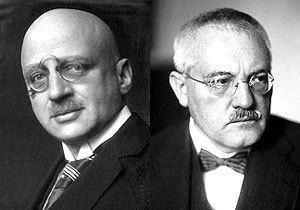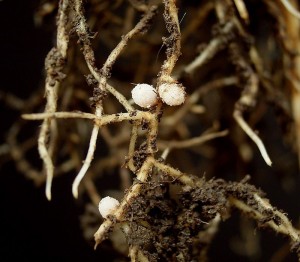Juan P. Alvez | Pasture Technical Coordinator, Center for Sustainable Agriculture – UVM Extension
Nitrogen is undisputedly, one of the most important macronutrients for plant growth, and a process invented by Haber-Bosh (Image 1) made it possible to produce nitrogen out of “thin air” and bag it to be applied in farm fields. Manufacturing fertilizer via Haber-Bosch requires vast amounts of energy (up to 3,600 psi of pressure and up to 1,022 ̊F). This is required to sever the nitrogen triple bond and combine it with hydrogen to form ammonia.

Image 1. Fritz Haber and Carl Bosch
You must be speculating how plants did to obtain nitrogen before this ambitiously engineered process was invented. If you thought ‘germs or microbes’ have anything to do with it, you got it very close. Although, you certainly remember your mom asking you to wash your hands (to avoid contamination with germs) before dinner. Microbes can also be great allies!
Soils also have many allies. For example, a soil bacterium genus Rhizobia, synergistically associates with legume roots to form a mutually beneficial partnership where rhizobia infects legume roots looking for the necessary energy (stored in plant sugars or carbohydrates). In return, rhizobia is able to sequester nitrogen from the atmosphere, making it available to plants for free. This is equivalent to having a nitrogen factory right in you farm!
To obtain this benefit, if specific soil bacteria is not present in the soil, it is necessary to inoculate legume seeds. Each legume seed has its own preferred rhizobia (e.g.: Clovers like “Rhizobium trifolii”).
The inoculation process

Image 2. Symbiosis between rhizobia and legumes roots cause pinkish nodules. Rhizobia benefits from sugars exudated by roots. Plants absorb nitrogen captureed and processed by rhizobia.
To inoculate, proceed by placing legume seeds in a bucket in the case of small quantities, or in a flat surface (it could be a swiped barn floor or on a tarp). In a clean container, mix warm water with inoculant and sugar to activate the rhizobium. Sugar will provide the stickiness to glue inoculant and seed. Next form a mound with the legume seeds. Open a “hole” in the middle of the seed mound and slowly start pouring the warm sweet gooey mix of rhizobia inoculant. Gently mix it with a shovel. Lastly, sprinkle lime over the mound until seeds get a whitish dry coat. This will also prevent the gooey stickiness from being transferred into the seeder forming clumps. When the mix is dry and loose, seed it. For more information, check this factsheet.
In general, establishing forage species can be as simple as broadcasting them in a pasture strip (by hand or with a spreader) just before animals are to be moved to a new strip or pasture. Use animals to briefly walk around the strip or paddock to promote seed-to-soil soil contact to stimulate better germination rates. This is the most inexpensive way to get legumes and nitrogen in your pastures however, be aware that rates of germination could be lower than when compared to no-till or tilling methods.
A good way to determine whether your legumes are infected with good nitrogen-fixing bacteria is to dig its roots to find round “pinkish” nodules (Image 2). Inoculated legumes will show a darker green color compared to non-inoculated ones, indicating the presence of nitrogen fixing bacteria.
The Haber-Bosh process granted its inventors two Nobel Prices, and was arguably one of the highest contributions to humanity in the last 200 years because, it enabled the production of nitrogen fertilizer which helped increased food production, allowing population to rise to a current 7 billion.
Rhizobia on the other hand, naturally fixes atmospheric nitrogen in the soil at a room temperature and everyday pressure. It is by no means a simple process and it is free.
Have you explored different successful forage management ideas? You can share them dropping us a line at the UVM Pasture Program:
Juan Alvez (jalvez@uvm.edu); Kimberly Hagen (kimberly.hagen@uvm.edu) and, Jennifer Colby (jcolby@uvm.edu)


[…] Remember that legumes need some special preparation (i.e.: inoculation) for maximum benefit (see next post, and check this factsheet). Annual or biennial forage species can provide feed supplementation […]
[…] Remember that legumes need some special preparation (i.e.: inoculation) for maximum benefit (see next post, and check this factsheet). Annual or biennial forage species can provide feed supplementation for […]